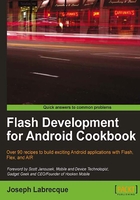
What this book covers
Chapter 1, Getting Ready to Work with Android: Development Environment and Project Setup, demonstrates the configuration of a number of development environments and tools which can be used in developing Flash content for mobile Android.
Chapter 2, Interaction Experience: Multitouch, Gestures, and Other Input, informs the reader with a variety of unique touch and gesture interactions that can be used across Flash Platform runtimes.
Chapter 3, Movement through Space: Accelerometer and Geolocation Sensors, empowers your applications with the ability to pinpoint a user's precise geographic location and even determine local changes in device shift and tilt through the on-board accelerometer.
Chapter 4, Visual and Audio Input: Camera and Microphone Access, discusses how to capture still images, video, and audio from integrated device hardware through both Flash based capture methods and while employing native camera applications.
Chapter 5, Rich Media Presentation: Working with Images, Video, and Audio, takes a look at a variety of media presentation mechanisms available to us on the Flash Platform including playback of progressive and streaming video, the use of Pixel Bender shaders, and even audio generation.
Chapter 6, Structural Adaptation: Handling Device Layout and Scaling, discusses a variety of methods we can use to gain detailed information regarding device displays, and the usage of this data when sizing and positioning visual elements along with structured layout through the mobile Flex framework.
Chapter 7, Native Interaction: Stage WebView and URI Handlers, demonstrates methods of utilizing native applications such as the Web browser, e-mail, SMS, Telephone, and Maps as extensions of our Flash based experience.
Chapter 8, Abundant Access: File System and Local Database, provides the readers with details of the steps necessary to access, open and write to file streams on the device storage, create and manage local SQLite databases, and preserve application state upon application interruption.
Chapter 9, Manifest Assurance: Security and Android Permissions, demonstrates the various Android Manifest permissions and provides examples of Market filtering, encrypted database support, and other security-minded techniques.
Chapter 10, Avoiding Problems: Debugging and Resource Considerations, looks at ways in which a developer can streamline the efficiency of an application by tapping into the device GPU, handling user interaction in responsible ways, and memory management techniques.
Chapter 11, Final Considerations: Application Compilation and Distribution, advises the reader on project preparation, code signing, release compilation, and distribution through the global Android Market.